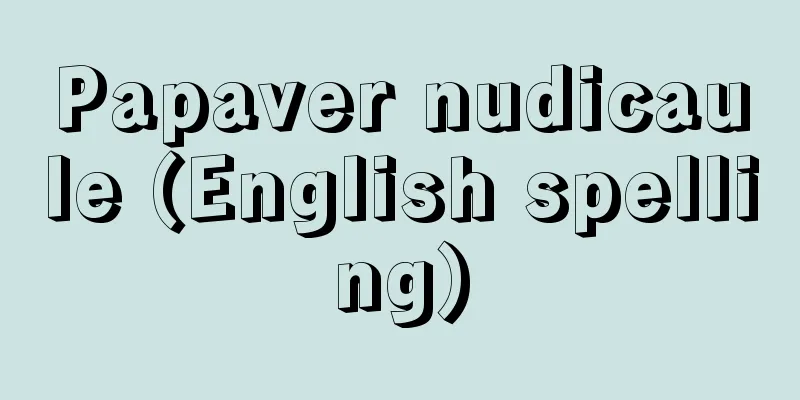Ooshikiami (English spelling) Large set-net of triangular shape

|
Among fishing nets, this is a type of fixed net platform net. It is made up of two parts: a fence net that blocks the passage of fish and guides them, and a bag net (enclosure net) that catches the fish that enter the net. The bag net is almost triangular in shape, with one side open as an entrance for the school of fish. This net was an early large-scale fixed net, and was used nationwide from the early Edo period to the end of the Meiji period, targeting fish that migrate along the coast, such as sardines, herring, yellowtail, and tuna. Lookout posts were set up on high ground or towers on land, and the net was hauled up after confirming that a school of fish had entered. The wide opening of the bag net made it easy for fish to enter, but its structure also made it easy for them to escape. As a result, it was improved and changed into the daibouami. The Daibouami has a rectangular bag net, a fence net attached to the joint between the main net on the upstream side and the opening, and screen nets placed inside the main net on both ends of the opening, making it difficult for fish caught in the bag net to escape. Later, both the Daishikiami and Daibouami disappeared, and were replaced by drop nets, which have better fishing efficiency. There are still some regions in Japan where large drop nets are called Daishikiami. Various types of set nets are used in foreign countries, but there are few large set nets. Among them, the large set nets for tuna used in Sicily, Italy, are a typical example, and their structure is similar to the Daibouami. [Hideo Soeda] [Reference items] | | | Fence | | | |Source: Shogakukan Encyclopedia Nipponica About Encyclopedia Nipponica Information | Legend |
|
漁業の網漁具のうち、定置網の台網(だいあみ)類の一種。魚の通路を遮断して誘導する垣網(かきあみ)と、網に入った魚を漁獲する袋網(囲網(かこいあみ))の2部で構成され、袋網の形は三角形に近く、その一辺が魚群の入口として開口している。この網は大型定置網の初期のもので、江戸時代初期から明治末期まで全国的に普及し、イワシ類、ニシン、ブリ、マグロ類など沿岸に回遊する魚類を対象とした。陸上の高台や櫓(やぐら)に見張り台を設置し、魚群が入網するのを確認してから揚網したが、袋網の網口が広いため魚が入網しやすい反面、逃げ出しやすい構造でもあった。そのため改良され、大謀網(だいぼうあみ)へとかわった。大謀網は、袋網を長方形とし、潮上(しおがみ)側の身網と端口(はぐち)の接点に垣網を結着させ、端口の両端に障子(しょうじ)網を身網の内側に設置するなどしたため、袋網に入網した魚が逃出しにくい構造となっている。その後、大敷網、大謀網とも姿を消し、漁獲効率のよい落し網類へと変遷した。日本には現在でも大型落し網を大敷網とよんでいる地方がある。外国でも各種の定置網で操業しているが、大型定置網は少ない。そのなかでも、イタリアのシチリア島で行われるマグロ大型定置網はその代表的なものであり、構造が大謀網に類似している。 [添田秀男] [参照項目] | | | | | | |出典 小学館 日本大百科全書(ニッポニカ)日本大百科全書(ニッポニカ)について 情報 | 凡例 |
<<: Mitsune Oshikouchi - The Three of Oshikouchi
Recommend
Thermal equilibrium
When a system of objects capable of exchanging hea...
Secession
An art movement that emerged in succession in Germ...
Bransfield, E.
…At the same time, voyages to the southern seas a...
Kanze Motonori
1845-1924 A Noh actor and drummer from the late E...
British Teachers' Union - UK Teachers Union
…Teaching unions were formed in European countrie...
Laemmle, C. (English spelling) LaemmleC
...In Japan, the company is officially registered...
Everglades Wetlands
…It has an area of 5,672 km2 and was designated...
Kanto Kokusuikai
...The group established headquarters in the Kant...
Odd permutation
A permutation obtained as the product of an odd nu...
Martin Heinrich Klaproth
German analytical chemist. Born in Wernigerode, K...
Yamatototohimomosohime no Mikoto
A daughter of Emperor Korei who appears in the Koj...
Schwab, G.
…Born in Tübingen, he studied law and literature ...
Arc de Triomphe - Gaisenmon
This arch is located at the western end of the Cha...
Catrapati
... The founder of the kingdom was Shibaji, whose...
Marunouchi - Marunouchi
A district in the eastern part of Tokyo's Chi...









